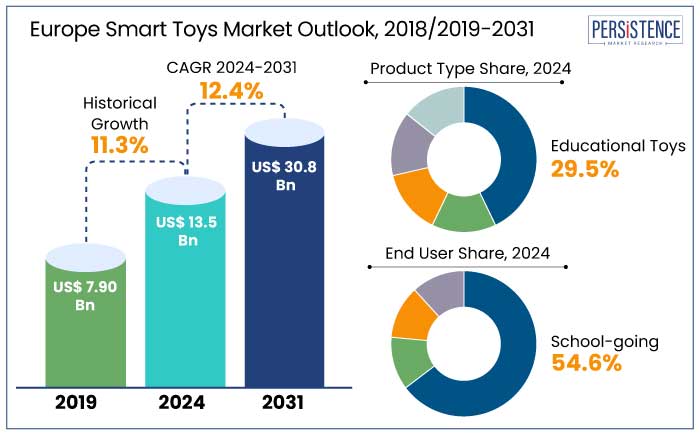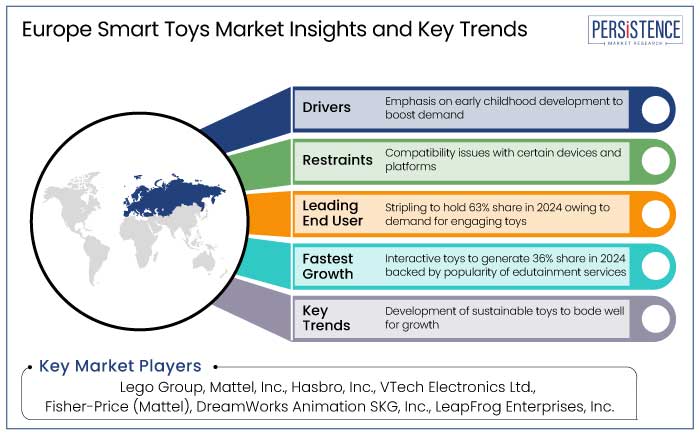Industry: Consumer Goods
Published Date: December-2024
Format: PPT*, PDF, EXCEL
Delivery Timelines: Contact Sales
Number of Pages: 194
Report ID: PMRREP34975
The Europe smart toys market is estimated to increase from US$ 13.5 Bn in 2024 to US$ 30.8 Bn by 2031. The market is projected to record a CAGR of 12.4% during the forecast period from 2024 to 2031.
Toys that combine teaching and enjoyment are becoming immensely popular among parents who understand the key role that early childhood development plays. Smart toys that include state-of-the-art technology offer engaging and instructive experiences that complement the goals of contemporary parents for their kids.
The need for toys that foster abilities like problem-solving and critical thinking is rising as the educational landscape changes. Children enjoy learning due to the immersive characteristics of smart toys, such as Augmented Reality (AR) and interactive storytelling, which create an engaging play experience.
LEGO Hidden Side, for instance, is a unique AR-enabled toy that allows kids to develop physical LEGO sets and then bring them to life through a companion app. The app smoothly blends the real and virtual worlds by superimposing digital ghosts and missions onto the physical model. The U.K. and Germany are among the leading markets in Europe where this product is offered.

Key Highlights of the Market
|
Market Attributes |
Key Insights |
|
Europe Smart Toys Market Size (2024E) |
US$ 13.5 Bn |
|
Projected Market Value (2031F) |
US$ 30.8 Bn |
|
Europe Market Growth Rate (CAGR 2024 to 2031) |
12.4% |
|
Historical Market Growth Rate (CAGR 2019 to 2023) |
11.3% |
The stripling (typically ages 0 to 14) segment emerged as the dominant end user in 2024, thereby driving the Europe smart toys market. This demographic has significantly contributed to the rising demand for smart toys, propelling the market to new heights. For example,
Smart toys, including educational, robotic, and remote-controlled vehicles, have become increasingly popular among children in this age group. These toys offer engaging, interactive play experiences that promote cognitive and developmental health.
As younger generations become more tech-savvy, demand for innovative, interactive, and educational toys has surged, fueling the rise of smart toys. This trend is anticipated to continue as more brands tailor products to meet the interests and learning needs of the stripling demographic, solidifying their dominant position in the market.
School-going kids, on the other hand, are anticipated to hold a share of nearly 54.6% in 2024. Smart toys, which are frequently made to encourage coding, robotics, and critical thinking, are seen as useful resources to improve learning in a fun and interesting way.
It is because modern parents and educators are becoming aware of the value of offering kids these types of skills. In addition to keeping kids' attention, these toys help them develop their creativity, problem-solving skills, and teamwork.
The interactive toys segment accounted for around 36% of the Europe smart toys market share in 2024, making it the most prominent contributor. This growth can be attributed to the expansion of edutainment services and increasing use of smartphones. These have become essential tools for interactive gaming. For example,
Interactive games provide a fun and engaging way for children to learn, offering creative methods for exploring knowledge. These games often involve solving puzzles or riddles within a virtual environment, fostering critical thinking and problem-solving skills.
They also serve as effective educational tools for young children, helping them grasp fundamental concepts such as letters and the alphabet in preschool. As more children engage with smartphones and interactive platforms, this segment is likely to continue driving the market's growth in the forecast period.
Educational toys, on the other hand, are anticipated to hold a share of about 29.5% in 2024. More emphasis on early childhood development and incorporation of technology into education are driving demand for educational toys in Europe.
The value of fostering children's cognitive, social, and emotional development from an early age is becoming apparent to parents. Children may develop their problem-solving, creative, and teamwork skills in an entertaining way with educational toys like STEM kits, puzzles, and interactive learning systems.
The Europe smart toys market is rapidly evolving due to rising consumer demand for interactive and educational play experiences. Smart toys integrated with IoT, AI, and AR/VR technologies provide children with enhanced learning opportunities, making them increasingly popular among parents. As consumers become more tech-savvy, there is a rising preference for toys that foster cognitive, social, and emotional development.
The market has also seen a surge in online sales, making smart toys easily accessible to parents. Trends indicate a rising focus on eco-friendly, educational, and health-oriented smart toys. These innovations are likely to foster the market in the next ten years, offering personalized and sustainable play options that cater to the changing needs of both parents and children.

The Europe smart toys market witnessed a significant CAGR of 11.3% in the historical period from 2019 to 2023. It was fueled by technological developments and rising consumer demand for educational products. The integration of AI, IoT, and AR also transformed the toy industry, providing children with more personalized and immersive play experiences. However, challenges like product safety concerns and high manufacturing costs impacted growth. For example,
The market is anticipated to maintain a strong growth trajectory, driven by rising adoption of smart devices and continuous technological innovations. Trends such as personalized and health-focused smart toys are anticipated to shape the market's future. These present opportunities for further innovation, ensuring the continued evolution of smart toys that cater to the changing needs of both children and parents.
Rising Awareness of the Benefits of Smart Learning Toys to Spur Sales
Surging awareness of the benefits of smart learning toys is a significant market growth driver. More parents are now recognizing their potential to enhance children’s cognitive, emotional, and social development. For example,
Smart learning toys integrate unique technologies like AI, IoT, and AR, offering interactive play experiences that adapt to a child’s learning pace. These toys engage children in educational activities such as problem-solving, language development, and creativity, while also making learning fun.
As parents increasingly seek educational products that provide long-term developmental benefits, demand for smart learning toys continues to rise. This shift toward more informed purchasing decisions is fueling market growth. Parents are set to value toys that combine entertainment with learning, ultimately supporting growth of the market.
AI Technology to Gain Traction as it Helps Enhance Toy Interactivity
Increasing use of AI technology to enhance toy interactivity is a key driver of market growth, as it allows toys to engage children in more personalized and dynamic play experiences. AI-powered toys can learn from interactions, adapt to a child’s behavior, and provide customized feedback, making play more engaging and educational. For instance,
Toys that recognize voice commands, understand emotions, or respond to changes in the environment offer children highly interactive and immersive play. As AI technology evolves, it continues to improve the functionality of smart toys. This makes the toys more intuitive and appealing to parents who seek products that foster creativity, problem-solving, and cognitive development, thereby driving growth of the market.
Complex Functionalities May Deter Non-tech-savvy Parents
Complex functionalities in smart toys may deter non-tech-savvy users, limiting their widespread adoption. While these toys offer novel features like AI, IoT connectivity, and interactive elements, they often require a certain level of technical knowledge to operate effectively.
Parents who are not comfortable with technology may find it challenging to set up or troubleshoot these toys, reducing their appeal. This complexity can also lead to frustration for both children and adults, especially if user-friendly instructions or intuitive interfaces are lacking. As a result, non-tech-savvy consumers may opt for simple, traditional toys, hindering demand among certain demographics. For example,
Limited Compatibility with Certain Devices or Platforms to Hamper Demand
Limited compatibility with specific devices or platforms is a significant factor impeding the Europe smart toys market. Various smart toys rely on certain operating systems, apps, or devices such as smartphones, tablets, or gaming consoles for full functionality.
If a toy is not compatible with widely used platforms or the consumer’s existing devices, it can lead to frustration and decreased demand. This issue is particularly relevant for parents who may not want to invest in new devices just to use a particular toy.
Compatibility concerns can further limit a toy’s appeal in areas or households where certain platforms are not very popular. As smart toys often require frequent updates or connectivity to perform optimally, limited cross-platform compatibility can be a leading barrier, reducing their market reach and adoption. For example,
Emergence of AI-based Educational Toys for Personalized Learning
Expansion of AI-based educational toys for personalized learning offers a transformative opportunity in the Europe smart toys market. By utilizing AI, these toys adapt to individual children’s learning speeds, preferences, and developmental milestones, providing customized educational experiences. Features such as real-time feedback, interactive problem-solving, and adaptive challenges not only enhance cognitive abilities but also maintain high levels of engagement.
The level of personalization resonates with parents seeking toys that blend entertainment with impactful learning. As AI technology accelerates, its deep integration into educational toys is likely to open new markets, appealing to tech-savvy families and fostering innovation. This trend is set to bolster substantial growth and diversification in the smart toys business.
Integration with Wearable Technology to Offer an Immersive Experience
Integration of smart toys with wearable technology presents an exciting future opportunity, offering a more immersive and interactive play experience. Wearable devices such as smartwatches, fitness trackers, or Augmented Reality (AR) glasses can enhance the functionality of smart toys.
The devices often enable real-time data exchange, motion tracking, and personalized feedback. This integration allows the toys to adapt to the child’s movements, physical activity, or even biometric data, creating a dynamic and engaging experience.
Wearable-enabled smart toys can combine physical and digital play, encouraging active participation and promoting health and fitness. Additionally, AR-based wearables can create imaginative, interactive environments that blend virtual and real-world experiences. As wearable technology becomes highly accessible, its integration with smart toys is anticipated to push innovation and extend market potential.
The competitive landscape in the Europe smart toy market is changing rapidly as consumer tastes move toward more technologically sophisticated and interactive play options. Businesses in this market are using cutting-edge technologies like Augmented Reality (AR), machine Learning (ML), and Artificial Intelligence (AI) to produce toys that foster cognitive growth and offer engaging experiences.
International firms like Lego Group, Mattel Inc., and Hasbro Inc., as well as niche tech-focused toy producers such as Anki and WowWee, are key participants in the Europe smart brain toys industry. Additionally, a few local businesses like Playmobil and Silverlit are diversifying their product lines to include smart toys. These companies compete in branding, collaborations, and digital content integration in addition to product innovation.
Recent Developments in the Europe Smart Toys Market
|
Attributes |
Details |
|
Forecast Period |
2024 to 2031 |
|
Historical Data Available for |
2019 to 2023 |
|
Market Analysis |
US$ Billion for Value |
|
Key Regions Covered |
|
|
Key Market Segments Covered |
|
|
Key Companies Profiled |
|
|
Report Coverage |
|
|
Customization and Pricing |
Available upon request |
By Product Type
By Technology
By End User
By Distribution Channel
By Country
To know more about delivery timeline for this report Contact Sales

The market is projected to be valued at US$ 13.5 Bn in 2024.
The industry is being propelled by developments in AI, IoT, and AR/VR technologies.
Lego Group, Mattel, Inc., Hasbro, Inc., and VTech Electronics Ltd. are a few leading brands.
The market is projected to rise at a CAGR of 12.4% from 2024 to 2031.
A prominent opportunity lies in the integration of AI and IoT technologies for personalized learning experience.